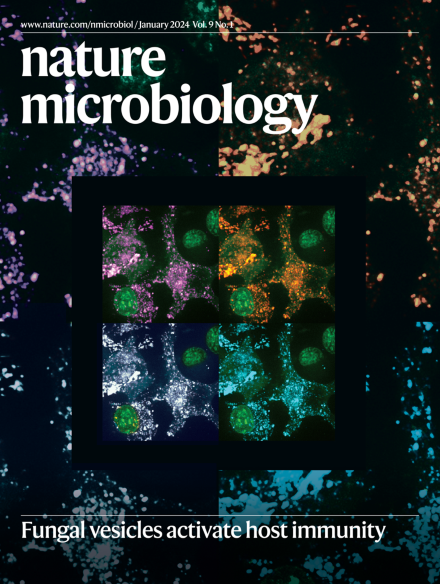一种喹诺酮类n -氧化物抗生素通过其毒素-抗毒素系统选择性靶向淋病奈瑟菌
IF 20.5
1区 生物学
Q1 MICROBIOLOGY
引用次数: 0
摘要
淋病是一种主要的性传播感染,耐多药淋病奈瑟菌的出现对全球健康构成威胁。为了确定淋病奈瑟菌的候选抗生素,我们筛选了铜绿假单胞菌衍生的次级代谢物,发现2-壬基-4-喹诺酮n -氧化物(NQNO)在体外可以抑制淋病奈瑟菌的生长。NQNO不影响共生奈瑟菌、阴道乳酸菌的生长和人类细胞的活力。机制上,NQNO破坏电子传递链,耗尽ATP和NADH水平,增加氧化应激。这触发了毒素-抗毒素系统的激活,内源性Zeta1毒素的释放和细菌死亡。在小鼠感染模型中,局部应用NQNO可阻止淋病奈瑟菌的定植。化学修饰得到的3-甲基NQNO对多药耐药菌株表现出纳米摩尔的效力,在小鼠实验感染过程中缺乏耐药性并显著减少病原体数量。这些发现表明,通过激活内源性毒素,有可能选择性地杀死细菌病原体,如耐多药淋病奈瑟菌。本文章由计算机程序翻译,如有差异,请以英文原文为准。


A quinolone N-oxide antibiotic selectively targets Neisseria gonorrhoeae via its toxin–antitoxin system
Gonorrhoea is a major sexually transmitted infection and the emergence of multidrug-resistant Neisseria gonorrhoeae poses a global health threat. To identify candidate antibiotics against N. gonorrhoeae, we screened Pseudomonas aeruginosa-derived secondary metabolites and found that 2-nonyl-4-quinolone N-oxide (NQNO) abrogated growth of N. gonorrhoeae in vitro. NQNO did not impair growth of commensal Neisseriae, vaginal lactobacilli or viability of human cells. Mechanistically, NQNO disrupted the electron transport chain, depleted ATP and NADH levels and increased oxidative stress. This triggered activation of a toxin–antitoxin system, release of the endogenous Zeta1 toxin and bacterial death. In a mouse model of infection, topical application of NQNO prevented colonization by N. gonorrhoeae. Chemical modification yielded 3-methyl NQNO, which exhibited nanomolar potency against multidrug-resistant strains, lack of resistance development and significantly reduced pathogen numbers during experimental infection of mice. These findings show the potential for selective killing of bacterial pathogens such as multidrug-resistant N. gonorrrhoeae through activation of endogenous toxins. Pseudomonas aeruginosa-derived 2-nonyl-4-quinolone N-oxide exerts bactericidal effects on Neisseria gonorrhoea via zeta1–epsilon1 toxin–antitoxin activation in vitro and abrogates experimental infection in mice.
求助全文
通过发布文献求助,成功后即可免费获取论文全文。
去求助
来源期刊

Nature Microbiology
Immunology and Microbiology-Microbiology
CiteScore
44.40
自引率
1.10%
发文量
226
期刊介绍:
Nature Microbiology aims to cover a comprehensive range of topics related to microorganisms. This includes:
Evolution: The journal is interested in exploring the evolutionary aspects of microorganisms. This may include research on their genetic diversity, adaptation, and speciation over time.
Physiology and cell biology: Nature Microbiology seeks to understand the functions and characteristics of microorganisms at the cellular and physiological levels. This may involve studying their metabolism, growth patterns, and cellular processes.
Interactions: The journal focuses on the interactions microorganisms have with each other, as well as their interactions with hosts or the environment. This encompasses investigations into microbial communities, symbiotic relationships, and microbial responses to different environments.
Societal significance: Nature Microbiology recognizes the societal impact of microorganisms and welcomes studies that explore their practical applications. This may include research on microbial diseases, biotechnology, or environmental remediation.
In summary, Nature Microbiology is interested in research related to the evolution, physiology and cell biology of microorganisms, their interactions, and their societal relevance.
 求助内容:
求助内容: 应助结果提醒方式:
应助结果提醒方式:


